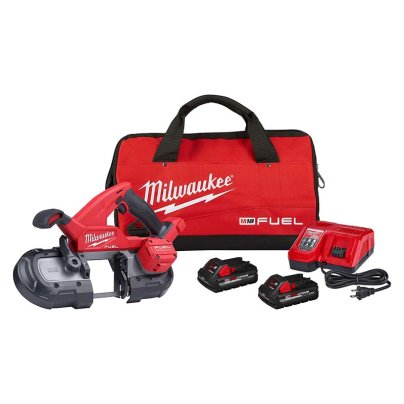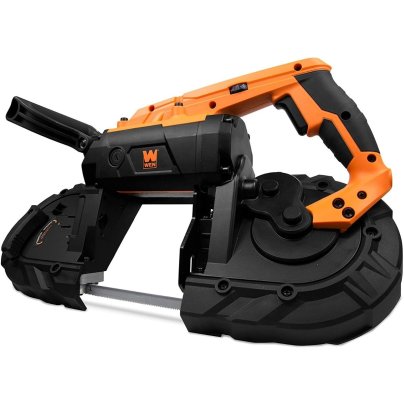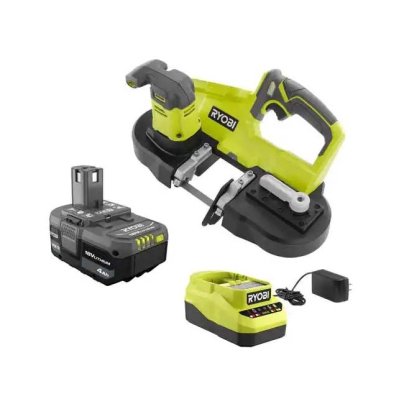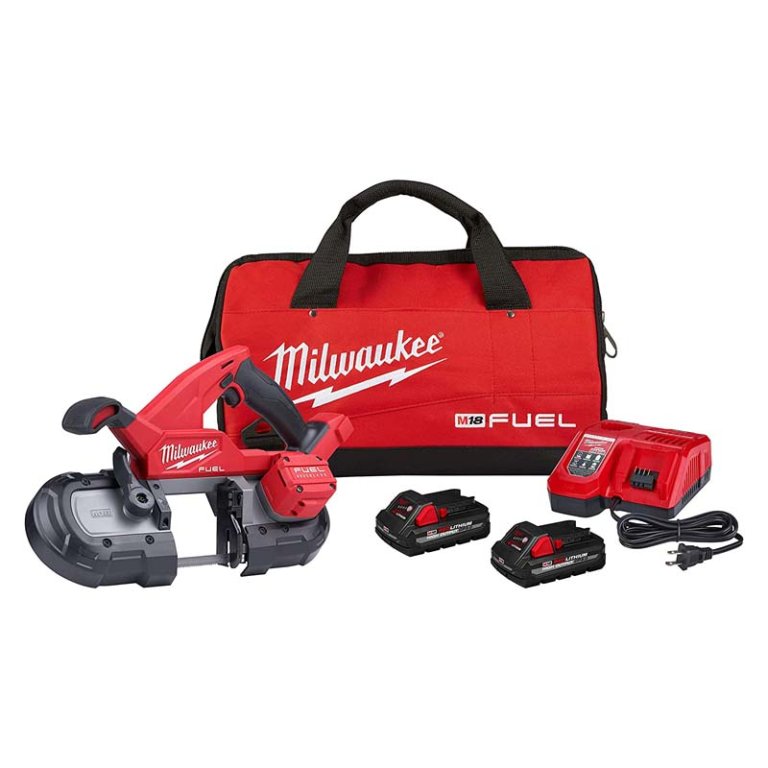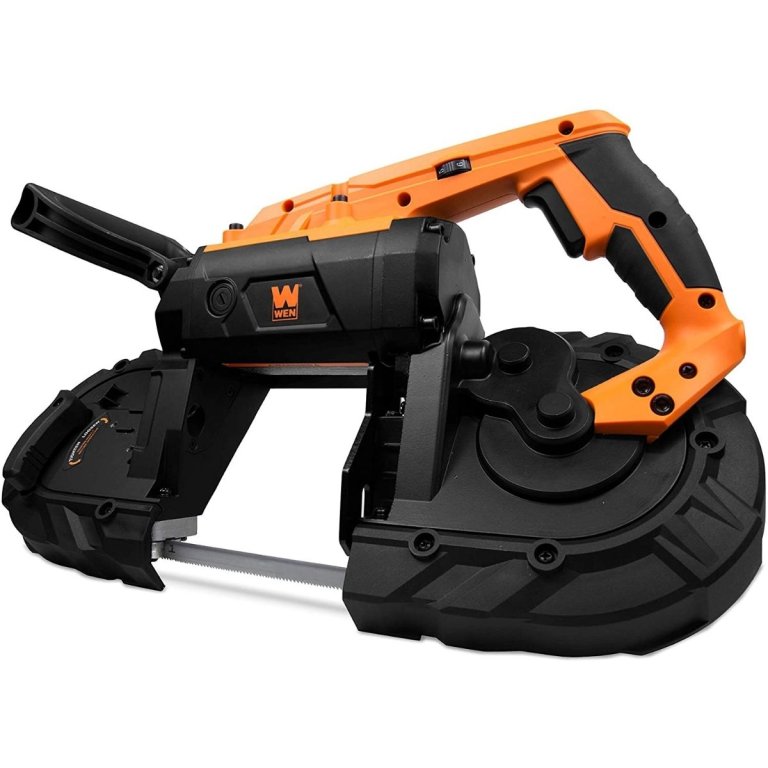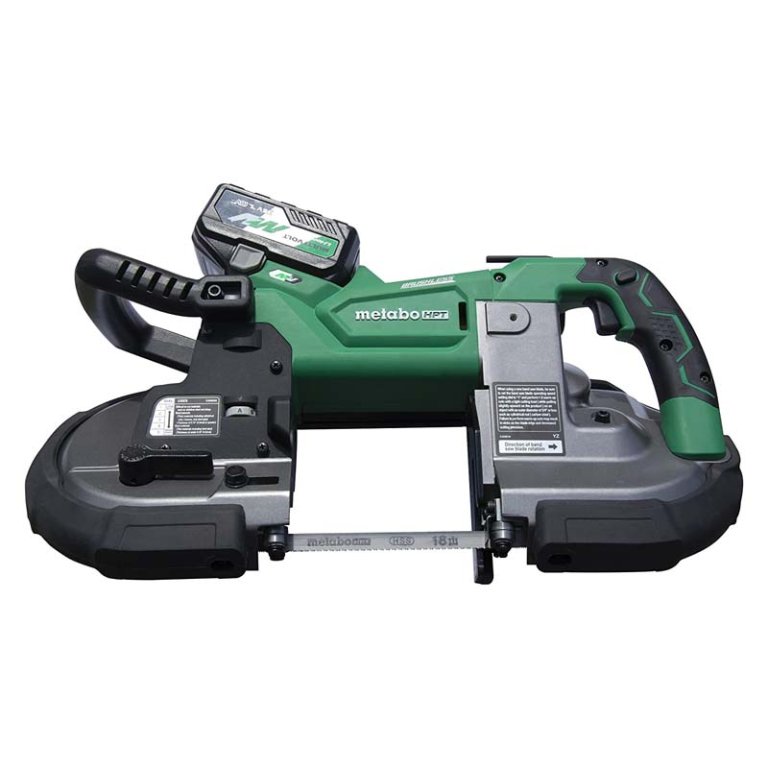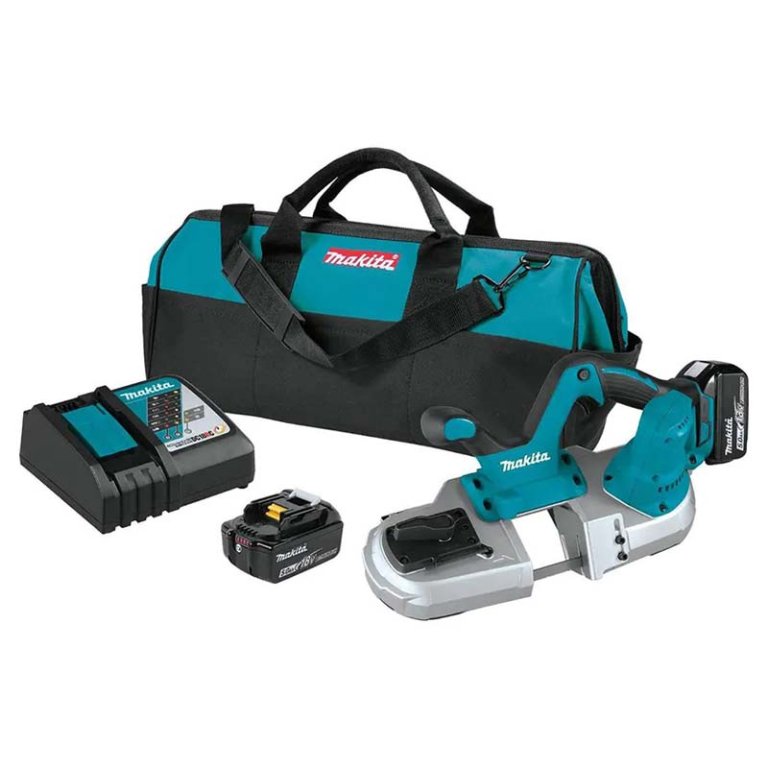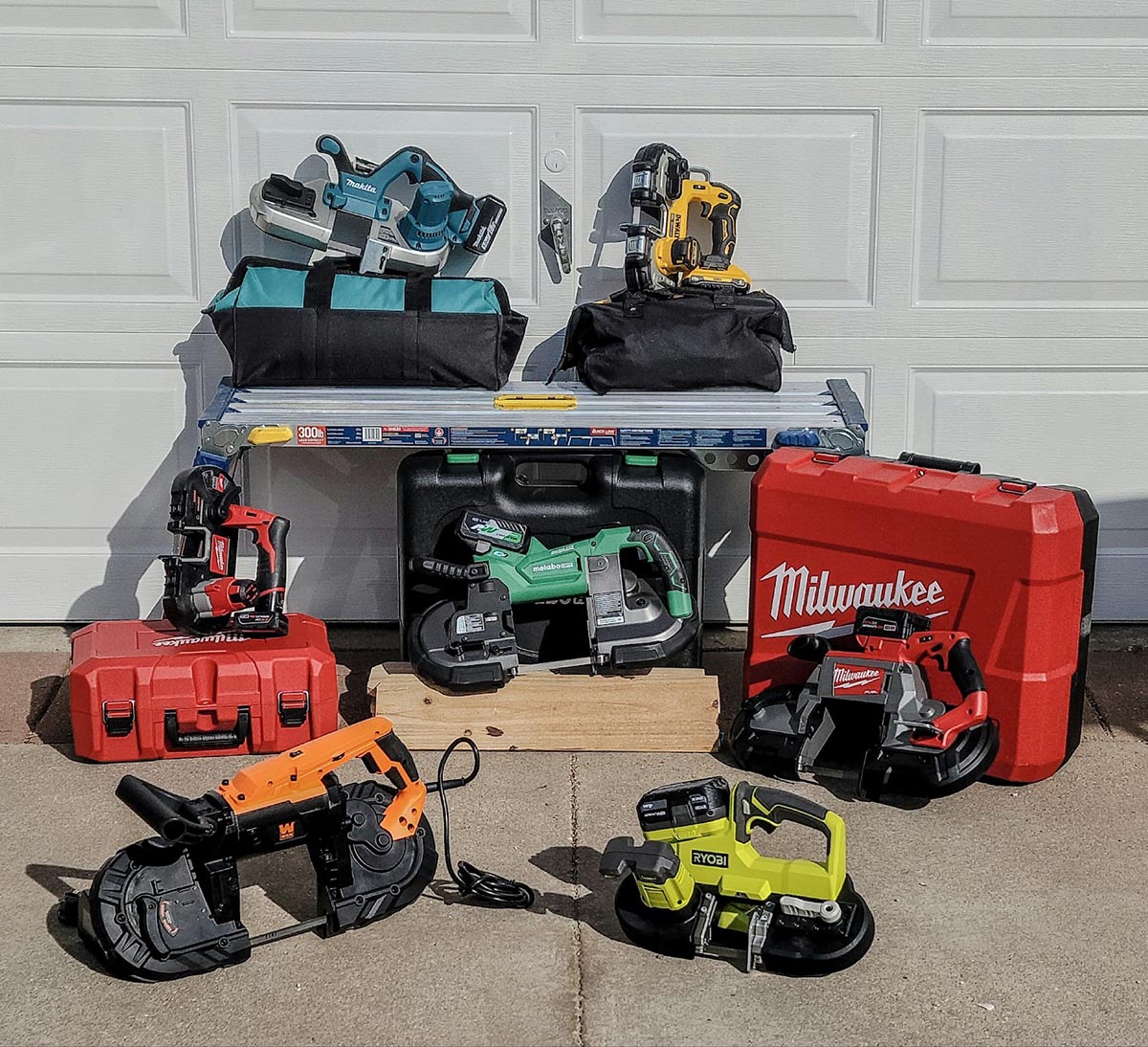
We may earn revenue from the products available on this page and participate in affiliate programs. Learn More ›
In the workshop, a freestanding band saw makes quick work of cutting metal pipes, rebar, conduit, or angle iron, but when material that needs to be cut can’t easily be transported to the workshop, you have to figure out a way to cut it on site. Using an angle grinder typically sends sparks flying, and a handheld hacksaw can create a sore elbow if there’s a lot of cutting to do.
An alternative is to invest in a portable band saw, which functions similarly to a freestanding band saw, but you can carry it on the job for making quick clean cuts when you need them. Since portable band saws are still relatively new, having shown up on the market only a decade or so ago, we tested them to find out how well they perform—and how safe they are for DIYers.
We also tested today’s best-selling portable band saws to determine their strengths, weaknesses, and best uses. We cut stainless steel, angle iron, metal pipes, ABS, PVC, and conduit, and we cut a whole lot of rebar while we were at it.
If you’re thinking about adding a portable band saw to your power tool collection, don’t miss this guide explaining the fine points. You’ll also find out how the following models all earned a spot in this lineup of some of the best portable band saws available today.
- BEST OVERALL: Milwaukee 2829-22 M18 Fuel Compact Band Saw Kit
- BEST BANG FOR THE BUCK: Wen 94396 10-Amp Variable Speed Portable Band Saw
- BEST FOR STABILITY: Ryobi P590K1 One+ 18V Cordless Band Saw Kit
- BEST SUBCOMPACT: Milwaukee 2429-21XC M12 Sub-Compact Band Saw Kit
- BEST HEAVY-DUTY: Metabo HPT CB3612DA 36V MultiVolt Deep Cut Band Saw
- BEST ADJUSTABLE SPEED: DeWalt DCS377Q1 Atomic 20V Max Cordless Band Saw Kit
- ALSO CONSIDER: Makita XBP03T 18V LXT Cordless Compact Band Saw Kit
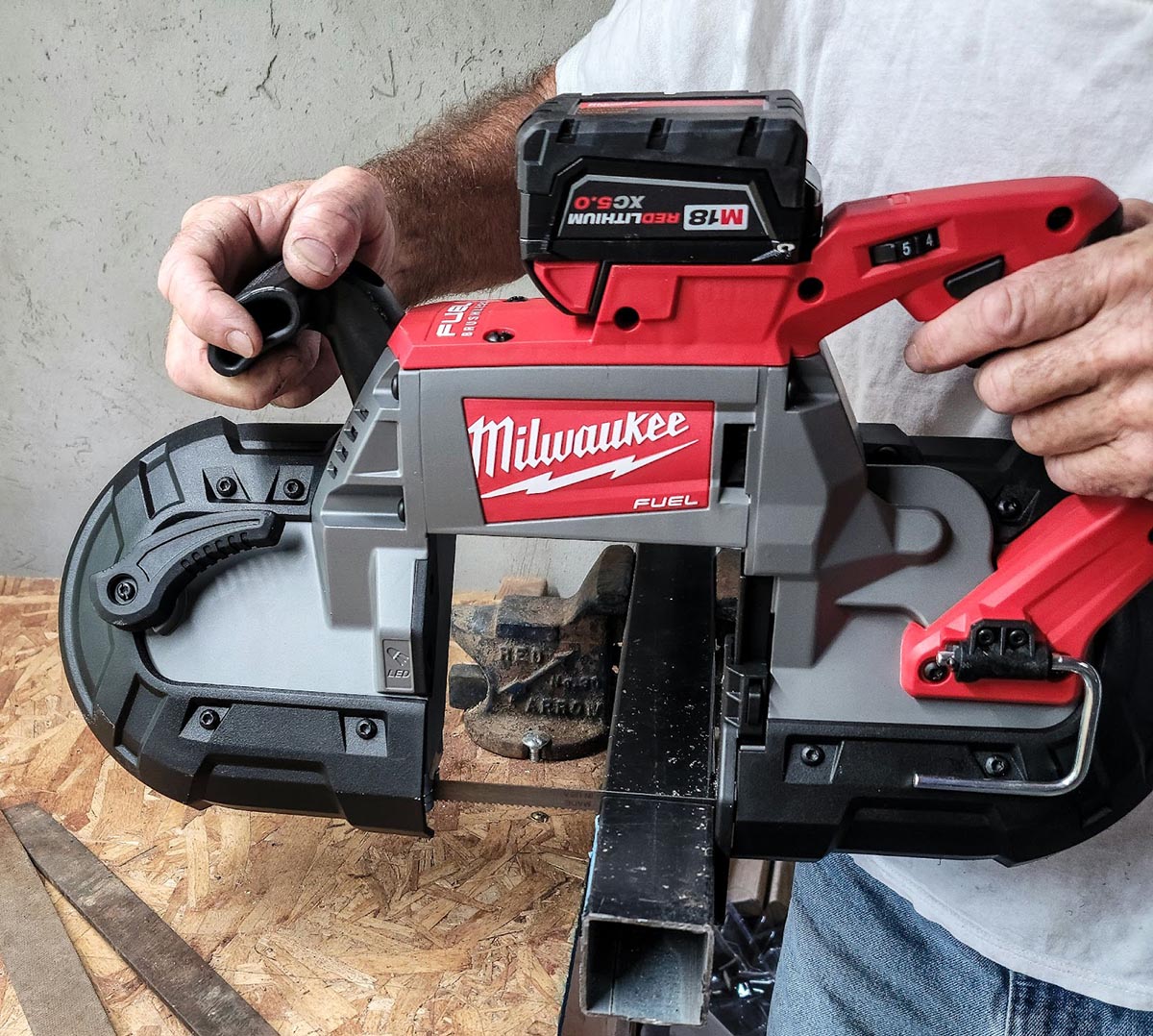
How We Tested the Best Portable Band Saws
Power, durability, and reliability were the key aspects we looked for when selecting portable band saws for hands-on testing. Brand reputation, usually well-deserved, was also considered in the research. However, less well-known models were also considered if they offered comparable performance and value. We chose to test full-size and compact models because both are becoming increasingly popular with DIYers and pros.
We first scrutinized the quality of the tools and charged the batteries fully (when applicable). Then the real testing started. Since portable band saws are mainly used for cutting metal—and since all the blades we received from the manufacturers were metal-cutting blades—we gathered a wide range of steel, copper, and aluminum pipes. We also collected numerous PVC pipes, conduits, angle iron, fence posts, and iron railings.
We wanted to have some cutting speed comparison, so we also had a stack of ⅝-inch rebar that we used for timed cuts. The process was straightforward—we placed the rebar in a vise, turned on the band saw, and then used a stopwatch to time the cutting duration from when the blade met the rebar to when the cut end fell away. We did not put any downward pressure on the band saws; instead, we allowed their weight to do the cutting.
As we tested the tools, we scored each one using a rubric—the better the performance, the higher the score they received. They also received scores based on how well we felt they functioned, and this included how smoothly they cut, the overall ergonomics of the tool, the amount of cutting capacity, and the speed of the cut. After testing, we added the scores and used them to determine the placement and the best category for each tool.

Our Top Picks
Now it’s time to look at the portable band saws that scored the highest in our hands-on tests. The following lineup consists of full-size and compact models, and while most are cordless, we also found a corded one that excelled. Find out how each portable band saw performed, its pros and cons, and the type of user best suited for each of these standout models.
Best Overall
Milwaukee 2829-22 M18 Fuel Compact Band Saw Kit
What We Like
- Optimal combination of weight and performance for smooth cutting action
- Includes battery and charger; compatible with other M18 Milwaukee products
- Second handle increases stability and accuracy while in use
What We Don’t Like
- Safety lock isn’t comfortably located on the grip; may not be very safe
- Pricey compared to other options on this list
Product Specs
- Power supply: 18V, cordless
- Cutting capacity: 3¼ inches by 3¼ inches
- Weight: 7.67 pounds (without battery)
This Bob Vila Approved product carries our brand’s highest level of recommendation.

Bob Vila Approved recognizes the household and DIY products that impressed us most in our real-world testing and that exemplify core values of the Bob Vila brand, including craftsmanship, innovation, and value for the dollar. Winners of this designation come recommended by our professional review team and are personally approved by Bob Vila.
Milwaukee is among the top names in power tool manufacturers, so we were expecting a lot from this portable band saw and we were not disappointed. One of Milwaukee’s newer models, the M18 Fuel is considered compact, although we found some full-size features on this tool. For instance, the M18 Fuel comes with dual handles—something that’s not always available on compact models, but something we appreciated for helping stabilize the tool while cutting.
We charged the 18-volt (V) lithium-ion battery that came with the tool and started testing. The M18 Fuel is ergonomically designed—the trigger handle comes with a nonslip grip and the second handle has a pummel knob. It was simple to install the metal cutting blade that comes with the saw and lock it into place. After that, we used a vice to hold pipes, angle iron, rebar, and more, and then started cutting.
As with all portable band saws, the tool’s weight does the cutting—don’t put pressure on the saw to increase cutting speed or risk damage to the cutting blade. This tool cuts at the rate of 540 FPM. We timed the tool, and it took 7 seconds to cut through a standard ⅝-inch rebar, making it well suited for a job where rebar is used to reinforce a concrete pour. It comes with a speed-adjustment dial as well.
The downside is the position of the safety lock that must be depressed before engaging the power trigger. It’s located above the trigger grip, but it’s challenging to hold the lock button down while simultaneously squeezing the trigger, which is required to activate the blade.
Get the Milwaukee M18 portable band saw at Amazon, The Home Depot, or Great Lakes Power Tools.
Best Bang for the Buck
Wen 94396 10-Amp Variable Speed Portable Band Saw
What We Like
- Made with ball-bearing blade guides for smooth operation; runs at 420 FPMs
- Deep-throat construction can cut through iron, steel, PVC, and conduit
- Corded construction provides continuous runtime on job sites or in workshops
- LED guide light provides ample visibility when cutting into various materials
What We Don’t Like
- Cord length limits range of use; not as portable as comparable options
Product Specs
- Power supply: 10 amps, corded
- Cutting capacity: 5 inches by 5 inches
- Weight: 14.5 pounds
A powerful portable band saw at an attractive price point, this Wen 94396 model contains ball bearings for the blade guides to keep things running smoothly. Its auxiliary handle is adjustable and runs at speeds up to 420 FPM. What makes it so affordable? It’s not battery-powered. The Wen comes with an electrical cord, so while it can’t be used on a job where there’s no electrical outlet, it can be used with an extension cord.
At 14.5 pounds, the Wen is heavier than some, but not excessively. We found the added weight helped speed up the cutting process. It took just 4 seconds to cut through the ⅝-inch rebar. We also tested the Wen by cutting angle iron, steel, PVC, and conduit. It sliced through all of them like butter.
With a cutting capacity of 5 inches by 5 inches, this is a deep-throat band saw that will cut through sizable items, and because it’s corded, it won’t lose power as long as an outlet is nearby. It features an LED guide light that helps cut in low-light situations, and because it doesn’t depend on recharging a battery, there is no downtime for charging. We had full power every time we cut.
Get the Wen portable band saw at Amazon or The Home Depot.
Best for Stability
Ryobi P590K1 One+ 18V Cordless Band Saw Kit
What We Like
- Wide range of applications; can be used on EMT, conduit, rebar, and more
- User-friendly construction has tool-free blade change and dual handles for safety and control
- Lightweight construction packs a lot of power; should not cause fatigue even with heavy-duty use
What We Don’t Like
- Unit only comes with one speed setting; may not be ideal for some users
Product Specs
- Power supply: 18V, cordless
- Cutting capacity: 2½ inches by 2½ inches
- Weight: 7.35 pounds (without battery)
The Ryobi One+ portable band saw packs a big cutting punch in a relatively small package. It weighs in at 7.35 pounds and features a 2½-inch-by-2½-inch cutting capacity that we found suitable for cutting many kinds of pipe, rebar, and steel balusters. The blade is exceptionally easy to change via a tool-free lever, so we didn’t have to tighten or loosen any fasteners with an Allen wrench, as is required with some tools.
Although it’s a compact model, it comes with dual handles that make it easy to grip and control. It features a maximum of 560 FPM, and it cuts through ⅝-inch rebar in 6.5 seconds. That’s pretty impressive for a lightweight band saw.
Our favorite thing, however, had to be how smoothly the Ryobi cut. The tool is so well balanced that we didn’t have to do much other than hold it, and the whirring band blade did the rest. Some of the other portable band saws we tested required a firmer grip to keep the tool aligned and balanced while cutting. The Ryobi doesn’t come with a speed adjustment, but it’s plenty fast enough to cut through most metal quickly. It features an LED guide light that shines directly on the material during cutting, which makes it handy in low-light situations.
Get the Ryobi portable band saw at The Home Depot or Amazon (tool only).
Best Subcompact
Milwaukee 2429-21XC M12 Sub-Compact Band Saw Kit
What We Like
- Molded grip and dual-latching lower blade guard allows for 1-handed operation; users can hold the material with one hand and cut with the other
- Variable speed trigger and LED light allow for ample control while in use
- The M12 battery is compatible with a range of Milwaukee products of the same voltage/battery type
What We Don’t Like
- Modest cutting capacity; suitable for small-scale cutting tasks
- No second handle for stability and accuracy while in use
Product Specs
- Power supply: 12V, cordless
- Cutting capacity: 1⅝ inches by 1⅝ inches
- Weight: 6.75 pounds (without battery)
At just 12 inches long and less than 6.75 pounds, the subcompact Milwaukee M12 portable band saw is the smallest tool we tested, yet its 1⅝-inch cut capacity is enough for many plumbers and electricians—and it’s built to the same standards as all Milwaukee tools. It doesn’t have quite the power of some of the bigger cordless band saws, but that’s mainly the result of having a less powerful battery—a 12V lithium-ion battery—as opposed to the 18V and 20V batteries in the larger tools.
While the cutting capacity wasn’t large enough to handle some of the bigger pipes we could cut with the other models, we were still able to test this little Milwaukee on smaller iron and steel objects, including rebar. It cuts at speeds up to 280 FPM, and it took the saw 12 seconds to cut through ⅝-inch rebar. While that’s not as fast as the other models, the tool is ergonomically designed, comfortable to use, and well-suited to restricted areas where a larger band saw won’t fit.
A slight downside is the lack of a second handle for stability. We found ourselves holding on to the battery to stabilize the saw while cutting. This is designed as a one-hand saw, but most users will likely want to use their other hand to ensure the cut is smooth and clean.
Installing the band blade was a snap using the tool’s built-in lever. While this subcompact tool doesn’t feature a speed adjustment dial, it has a variable speed trigger that made it easy to select the best speed for the material we were cutting. We feel this small portable band saw is well suited to DIY pipe-cutting tasks but less suited to heavy-duty jobs, such as repeated rebar cuts.
Get the Milwaukee M12 portable band saw at Amazon, The Home Depot, or New York Power Tools.
Best Heavy-Duty
Metabo HPT CB3612DA 36V MultiVolt Deep Cut Band Saw
What We Like
- One of the most powerful options available at 640 FPM; sliced through ⅝-inch rebar in 3.5 seconds
- Dual handles for firm gripping and accuracy while in use; under-grip provided
- Integrated LED light allows for great visibility while the user is cutting
- Surprisingly quiet operation when cutting through materials
What We Don’t Like
- On the weighty side at 16.5 pounds; may cause fatigue during long-term use
Product Specs
- Power supply: 36V, cordless
- Cutting capacity: 4¾ inches by 4¾ inches
- Weight: 16.5 pounds (with battery)
The Metabo HPT MultiVolt Band Saw weighs in at a hefty 16.5 pounds, but that added weight, combined with its 36V of power, allows it to slice right through steel and iron. The timed rebar test took just 3.5 seconds to cut through the ⅝-inch rebar, making this the most powerful of all the portable band saws we tested. It even beat out our corded model.
At top speed, the Metabo runs at 640 FPM, and we learned that we needed to make sure we had the blade perfectly aligned because once it starts cutting, it goes quickly. One of the nicest things about this model is its dual loop handles, which allowed us to use an under-grip rather than just holding on to a stabilizing knob. With a weightier tool, a loop handle like this makes it easier to lift the saw when needed.
The cutting capacity on the Metabo is 4¾ inches by 4¾ inches, which gives us ample room to cut various pipes, angle iron, and other metal items. We even cut through a 4-inch by 4-inch steel fence post with ease. The saw features an adjustable speed dial and a nice LED light that clearly lights up the material being cut.
Interestingly, although this is a heavy-duty saw, we found it was surprisingly quiet while cutting. This powerful saw would be at home on a remodeling project or on a construction site for making quick metal cuts on the fly.
Get the Metabo portable band saw at Amazon, Lowe’s, or Acme Tools.
Best Adjustable Speed
DeWalt DCS377Q1 Atomic 20V Max Cordless Band Saw Kit
What We Like
- Lightweight enough to use one-handed overhead; perfect for job sites
- Good LED guide light provides ample illumination while cutting
- Variable speed trigger allows for excellent control over the cutting speed
What We Don’t Like
- No second handle integrated into the design; may not be as comfortable to handle
- Not as balanced as some other options on the market
Product Specs
- Power supply: 20V, cordless
- Cutting capacity: 1¾ inches by 1¾ inches
- Weight: 6.6 pounds
DeWalt jumps right into the compact band saw market with its new Atomic 20V Max cordless portable band saw that weighs just 6.6 pounds, yet generates 380 FPM. This notable cutting speed allowed the Atomic to cut through ⅝-inch rebar in 10 seconds, making it well-suited for cutting pipes, conduits, and more around the house or on the job.
A blade lever release made installing the band blade easy, and we liked the LED guide light that lit up a large area. The smaller, 1¾-inch-by-1¾-inch cutting capacity is still big enough to cut a range of metal, iron baluster, and PVC pipes. The tool is designed to be used with one hand, but like the other compact models we tested, we found ourselves wishing it had a second handle to help stabilize the saw while cutting. However, the battery is well-placed for using it as a second handle.
While it has more power than the 12V model we tested, it still didn’t compare in power to the bigger models. The Atomic comes with both a speed dial and a variable speed trigger. We found it easier to use the variable speed trigger to adjust the speed. While we don’t think the Atomic will hold up to the repetitive cutting of heavy steel and iron, it does an excellent job of making clean cuts on smaller items.
Get the DeWalt portable band saw at Amazon, The Home Depot (tool only), or Acme Tools.
Also Consider
Makita XBP03T 18V LXT Cordless Compact Band Saw Kit
What We Like
- High-quality, reliable tool can cut at 630 FPM speeds; cut through a bar in 3 seconds
- Dual handled design allows for a comfortable hold and accuracy
- Trigger grip and LED light allow for user-friendliness
What We Don’t Like
- Loud operating volume compared to other options on this list
Product Specs
- Power supply: 18V, cordless
- Cutting capacity: 2½ inches by 2½ inches
- Weight: 9 pounds (with battery)
Our first impression of the Makita portable band saw was that it was not too heavy but not too light, either. It’s just about the right size and weight for comfortable repeated use. Although this is a compact portable band saw, it cuts at high speeds of up to 630 FPM, putting it in the category of prosumer-quality tools. It excelled in our timed rebar test—cutting through the bar in just 3 seconds.
We loved how quietly this tool operates. Besides the sound of the blade cutting through the material, the actual motor noise was quiet. The manufacturer doesn’t provide a decibel level, but we estimated it was around 70 decibels, or about the sound of busy traffic. Safety features include overload protection and a safety switch to prevent accidental starting. It also includes an LED work light.
The Makita portable band saw weighs in at 9 pounds when the battery is installed, making it lightweight enough to cut overhead pipes or bars without arm fatigue. It’s very ergonomic and comfortable to use—the trigger grip is nonslip, and the tool features a second pommel handle for stability. The cutting capacity isn’t as large as some, just 2½ inches by 2½ inches, but it’s plenty spacious for cutting standard residential vent pipes, conduit, and water supply lines.
For those who regularly cut pipes, metal railings, and rebar, this Makita portable band saw—although pricey—will likely be an asset and a timesaver. The tool comes with an 18V, 5Ah lithium-ion battery. While other 18V Makita batteries may fit the tool, they will not provide as much power if they’re less than 5Ah.
Get the Makita portable band saw at Amazon or The Home Depot.
Jump to Our Top Picks
What to Consider When Choosing a Portable Band Saw
A portable band saw is used to make straight cuts on bars and pipes, making it well suited for those in the remodeling or plumbing fields. Due to its limited throat capacity, cutting curves isn’t recommended. The portable band saw makes straight 90-degree cuts, such as those made when removing a section of pipe for splicing.
Power Source
Battery technology has made great progress as a power source, making high-performance cordless tools widespread. However, buying a corded portable band saw can mean saving as much as 50 percent over a comparable cordless model. Plus, there’s no need to recharge batteries. Moreover, to use a cordless tool all day, users typically need at least one spare battery. If buying a spare, always choose the highest amp hour (Ah) rating possible to maximize runtime.
Cords for portable band saws usually run around 8 feet long, so an extension cable is often required with a corded model, which can become inconvenient at times. However, many jobsites have a generator for a power supply, and home users usually have a nearby outlet.
Cutting Capacity
One of the most important differences in portable band saw specifications is the cutting capacity. The necessity to cut material to a particular size may narrow the universe of choices. Width and depth dimensions are almost always the same, but check to be sure. The products in this list all have square dimensions.
- “Width of cut” means the length of the band saw blade available for cutting or the distance between the two sides of the body that house the band saw wheels.
- “Depth of cut” refers to the distance from the blade to the back of the frame.
Small models designed for one-handed use may have a maximum cut of around 1½ inches by 1½ inches, whereas the largest portable band saws typically are 5 inches by 5 inches.
Speed and Blade Type
Portable band saw speed is described in SFPM (surface feet per minute) or, more often, simply “FPM,” sometimes written as “ft/min.” Portable models run anywhere from 0 to 550 FPM, which allows for cutting a wide variety of different materials.
Sometimes variable speed is simply trigger operated. However, many machines are capable of up to six speed ranges. A handle-mounted thumb wheel adjusts the speed, making it easier to change and control the saw speed.
A portable band saw is typically considered a metal-cutting tool, and some are described as such. A general-purpose blade for metals, with 14 to 18 teeth per inch (TPI), is usually provided with the machine. However, a wide choice of wood-cutting blades, usually 8 to 10 TPI, are also available.
When looking for replacements or alternatives for different materials, manufacturers’ descriptions provide guidance on performance. Always invest in quality blades; cheap band saw blades wear down quite quickly.
Size and Portability
Obviously, the key factors in choosing a portable band saw are its size and weight. DIY users may not be overly concerned, but those who use a tool all day, particularly above head height, will usually want to minimize bulk.
Although aluminum and plastic components make a saw lighter, the overuse of plastics can affect durability on a low-priced portable band saw. When checking the weight of a cordless portable band saw, remember that the battery weight may not be included in the specifications. Most batteries weigh about 1 pound.
If working in a confined space, also consider external dimensions. Some compact and subcompact portable band saws are designed for single-handed use. Larger models usually have an auxiliary handle near the front for better control, which can typically be adjusted for working at different angles.
Bumpers, Cases, Lighting, and Bare Tools
Rubber bumpers are often fitted around the exterior of the wheel shrouds. Because they absorb day-to-day impacts, they’re often valuable in protecting the tool from damage.
A storage case is also useful, but they aren’t always provided. Some portable band saws include LED work lights to help brighten dark corners.
Cordless portable band saws are often sold as “bare tools,” which means the battery or charger is not included. With compatible equipment, this can mean sizable savings, but check compatibility if the existing tools are more than 5 years old.
The Advantages of Owning the Best Portable Band Saw
Portable band saws have no real competitors. Jigsaws don’t have the capacity and are not designed for cutting round material. The vibration of a reciprocating saw means it’s not a tool for precision work, and angle grinders are slower and create sparks.
- Portable band saws come in various sizes for one- or two-handed use.
- When used correctly and users let the weight of the saw do the work, they run smoothly, allowing for precise cuts.
- With the correct blade, they can cut steel and nonferrous metals, wood, plastic, PVC, composites, etc. However, most band saw blades are made for cutting metal.
- Affordable models are available for the DIY user.
Safety Tips for Using a Portable Band Saw
Following general band saw safety guidelines helps prevent some of the potential dangers of using a saw, but a portable band saw presents some challenges of its own.
- If new to using a portable band saw, make a few practice cuts on scrap material to get acquainted with the tool.
- Wear gloves when changing the blade. Even though the blade may be too dull to cut metal, it can still cut fingers. Ensure the tool is unplugged or the battery removed before attempting to change a blade.
- The wheels and blade can pick up and throw debris, so make sure the tool comes to a complete stop before putting it down.
- Frequently check the blade tension. Loose blades cut poorly and, in extreme cases, could come off the wheels.
- Always wear eye protection when using a portable band saw.
- Be aware of where the cut piece of material will fall and use gloves to pick it up. Just-cut metal can be very hot.
FAQs
Reading through this information should provide consumers with valuable insight into how to find the best portable band saw for specific tasks. However, there may be lingering questions. We’ve answered some of the most popular questions below.
It’s difficult to say how long a portable band saw will last, because so much depends on the amount of use it gets and the working environment. Professionals can expect at least several years of use, while DIY users may be able to use theirs for much longer.
Each manufacturer provides a guide to cleaning and general maintenance. Follow the instructions to maximize performance and tool life. In general, waste gathers around the band saw wheels, which can be cleaned with either an air gun or shop vac. If spots of rust appear on the blade, wipe with a noncorrosive liquid rust remover.
It varies, so check the specifications. These top picks demonstrate the wide variety available, but the maximum is usually around 5 inches.
If you have sufficient use to justify the investment, absolutely. No other portable saw offers the same combination of power and material-cutting versatility.
Meet the Tester
Glenda Taylor is a product tester and writer specializing in the construction, remodeling, and real estate industries. She and her husband own a general contracting company, and Taylor is experienced in both residential and commercial building applications. She tests a wide range of power tools as well as other home improvement, household, and lawn-and-garden products.
